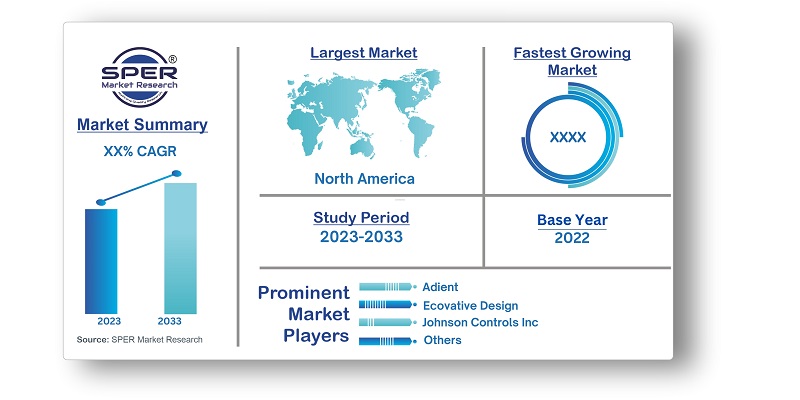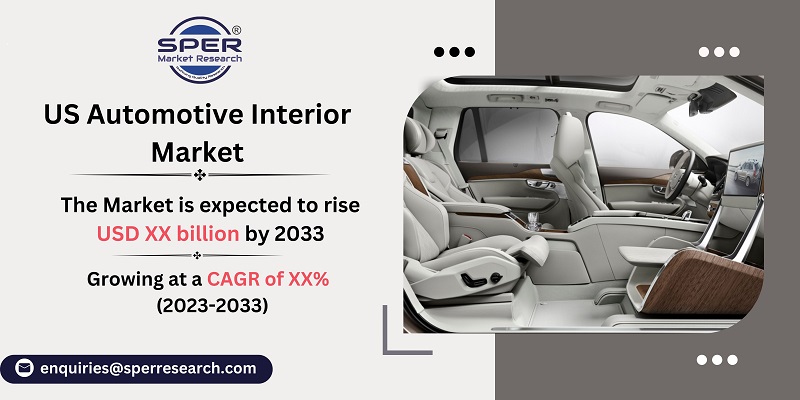
US Automotive Interior Market Trends, Growth, Revenue, Size, Share, Demand and Future Outlook
US Automotive Interior Market Size- By Component, By Material, By Level of Autonomy, By Electric Vehicle, By Passenger Car Class, By Vehicle Type- Regional Outlook, Competitive Strategies and Segment Forecast to 2033
| Published: Sep-2023 | Report ID: AMIN23143 | Pages: 1 - 102 | Formats*: |
| Category : Automotive & Transportation | |||

- Opportunities: Given that the forthcoming main models have been designed with a greater number of screens, automakers are experimenting with screen size and number. The infotainment system has advanced greatly in recent years. The growth of new infotainment systems will be accompanied by a rise in screen size and quantity. Many people will favour the vehicle with the biggest screen and best entertainment system as more autonomous vehicles hit the road. As a result, the market for infotainment systems could grow over the forecast period creating the opportunities for the automotive interior market.
- Challenges: The growth of the vehicle interior materials industry in recent years has been hampered by the weak or stagnant growth of the world's major automobile markets. The automotive industry's expansion in China and several other places has been further hampered by the coronavirus outbreak there. Furthermore, the global automotive industry has been negatively impacted by shifting regulatory standards for car emissions. Therefore, it is anticipated that market growth will be constrained during the projected period due to the rising frequency of these disruptions in the automotive industry.

| Report Metric | Details |
| Market size available for years | 2019-2033 |
| Base year considered | 2022 |
| Forecast period | 2023-2033 |
| Segments covered | By Component, By Material, By Level of Autonomy, By Electric Vehicle, By Passenger Car Class, By Vehicle Type |
| Regions covered | Midwest Region, Northeast Region, South Region, Southwest Region, West Region and rest of US |
| Companies Covered | Adient, Ecovative Design, GST AutoLeather, Inc., Johnson Controls Inc., Lear Corporation, Sage Automotive Interiors, Inc., SMS Auto Fabrics, Visteon, Others |
- Aftermarket Retailers
- Automobile Manufacturers
- Automotive Dealerships
- Automotive Designers
- Consumers and Vehicle Owners
- Fleet Management Companies
- Interior Designers and Consultants
- Suppliers and Manufacturers
- Others
| By Component: | |
| By Material: | |
| By Level of Autonomy: | |
| By Electric Vehicle: | |
| By Vehicle Type: |
- US Automotive Interior Market Size (FY’2023-FY’2033)
- Overview of US Automotive Interior Market
- Segmentation of US Automotive Interior Market By Component (Center Stack, Dome Module, Headliner, Head-Up Display, Instrument Cluster, Interior Lighting, Rear Seat Entertainment, Seat)
- Segmentation of US Automotive Interior Market By Material (Carbon Fiber Composite, Fabric, Glass Fiber Composite, Leather, Metal, Vinyl, Wood)
- Segmentation of US Automotive Interior Market By Level of Autonomy (Autonomous, Non-Autonomous, Semi-Autonomous)
- Segmentation of US Automotive Interior Market By Electric Vehicle (BEV, FCEV, HEV, PHEV)
- Segmentation of US Automotive Interior Market By Passenger Car Class (Economic Cars, Luxury Segment Cars, Mid Segment Cars)
- Segmentation of US Automotive Interior Market By Vehicle Type (Heavy Commercial Vehicle, Light Commercial Vehicle, Passenger Car)
- Statistical Snap of US Automotive Interior Market
- Expansion Analysis of US Automotive Interior Market
- Problems and Obstacles in US Automotive Interior Market
- Competitive Landscape in the US Automotive Interior Market
- Impact of COVID-19 and Demonetization on US Automotive Interior Market
- Details on Current Investment in US Automotive Interior Market
- Competitive Analysis of US Automotive Interior Market
- Prominent Players in the US Automotive Interior Market
- SWOT Analysis of US Automotive Interior Market
- US Automotive Interior Market Future Outlook and Projections (FY’2023-FY’2033)
- Recommendations from Analyst
1.1. Scope of the report1.2. Market segment analysis
2.1. Research data source2.1.1. Secondary Data2.1.2. Primary Data2.1.3. SPER’s internal database2.1.4. Premium insight from KOL’s2.2. Market size estimation2.2.1. Top-down and Bottom-up approach2.3. Data triangulation
4.1. Driver, Restraint, Opportunity and Challenges analysis4.1.1. Drivers4.1.2. Restraints4.1.3. Opportunities4.1.4. Challenges4.2. COVID-19 Impacts of the US Automotive Interior Market
5.1. SWOT Analysis5.1.1. Strengths5.1.2. Weaknesses5.1.3. Opportunities5.1.4. Threats5.2. PESTEL Analysis5.2.1. Political Landscape5.2.2. Economic Landscape5.2.3. Social Landscape5.2.4. Technological Landscape5.2.5. Environmental Landscape5.2.6. Legal Landscape5.3. PORTER’s Five Forces5.3.1. Bargaining power of suppliers5.3.2. Bargaining power of buyers5.3.3. Threat of Substitute5.3.4. Threat of new entrant5.3.5. Competitive rivalry5.4. Heat Map Analysis
6.1. US Automotive Interior Market Manufacturing Base Distribution, Sales Area, Product Type6.2. Mergers & Acquisitions, Partnerships, Product Launch, and Collaboration in US Automotive Interior Market
7.1. US Automotive Interior Market Value Share and Forecast, By Component, 2023-20337.2. Center Stack7.3. Dome Module7.4. Headliner7.5. Head-Up Display7.6. Instrument Cluster7.7. Interior Lighting7.8. Rear Seat Entertainment7.9. Seat
8.1. US Automotive Interior Market Value Share and Forecast, By Material, 2023-20338.2. Carbon Fiber Composite8.3. Fabric8.4. Glass Fiber Composite8.5. Leather8.6. Metal8.7. Vinyl8.8. Wood
9.1. US Automotive Interior Market Value Share and Forecast, By Level of Autonomy, 2023-20339.2. Autonomous9.3. Non-Autonomous9.4. Semi-Autonomous
10.1. US Automotive Interior Market Value Share and Forecast, By Electric Vehicle, 2023-203310.2. BEV10.3. FCEV10.4. HEV10.5. PHEV
11.1. US Automotive Interior Market Value Share and Forecast, By Passenger Car Class, 2023-203311.2. Economic Cars11.3. Luxury Segment Cars11.4. Mid Segment Cars
12.1. US Automotive Interior Market Value Share and Forecast, By Vehicle Type, 2023-203312.2. Heavy Commercial Vehicle12.3. Light Commercial Vehicle12.4. Passenger Car
13.1. US Automotive Interior Market Size and Market Share
14.1. US Automotive Interior Market Size and Market Share By Component (2019-2026)14.2. US Automotive Interior Market Size and Market Share By Component (2027-2033)
15.1. US Automotive Interior Market Size and Market Share By Material (2019-2026)15.2. US Automotive Interior Market Size and Market Share By Material (2027-2033)
16.1. US Automotive Interior Market Size and Market Share By Level of Autonomy (2019-2026)16.2. US Automotive Interior Market Size and Market Share By Level of Autonomy (2027-2033)
17.1. US Automotive Interior Market Size and Market Share By Electric Vehicle (2019-2026)17.2. US Automotive Interior Market Size and Market Share By Electric Vehicle (2027-2033)
18.1. US Automotive Interior Market Size and Market Share By Passenger Car Class (2019-2026)18.2. US Automotive Interior Market Size and Market Share By Passenger Car Class (2027-2033)
19.1. US Automotive Interior Market Size and Market Share By Vehicle Type (2019-2026)19.2. US Automotive Interior Market Size and Market Share By Vehicle Type (2027-2033)
20.1. US Automotive Interior Market Size and Market Share By Region (2019-2026)20.2. US Automotive Interior Market Size and Market Share By Region (2027-2033)20.3. Midwest Region20.4. Northeast Region20.5. South Region20.6. Southwest Region20.7. West Region20.8. Rest of US
21.1. Adient21.1.1. Company details21.1.2. Financial outlook21.1.3. Product summary21.1.4. Recent developments21.2. Ecovative Design21.2.1. Company details21.2.2. Financial outlook21.2.3. Product summary21.2.4. Recent developments21.3. GST AutoLeather, Inc.21.3.1. Company details21.3.2. Financial outlook21.3.3. Product summary21.3.4. Recent developments21.4. Johnson Controls Inc.21.4.1. Company details21.4.2. Financial outlook21.4.3. Product summary21.4.4. Recent developments21.5. Lear Corporation21.5.1. Company details21.5.2. Financial outlook21.5.3. Product summary21.5.4. Recent developments21.6. Sage Automotive Interiors, Inc.21.6.1. Company details21.6.2. Financial outlook21.6.3. Product summary21.6.4. Recent developments21.7. SMS Auto Fabrics21.7.1. Company details21.7.2. Financial outlook21.7.3. Product summary21.7.4. Recent developments21.8. Visteon21.8.1. Company details21.8.2. Financial outlook21.8.3. Product summary21.8.4. Recent developments21.9. Others
SPER Market Research’s methodology uses great emphasis on primary research to ensure that the market intelligence insights are up to date, reliable and accurate. Primary interviews are done with players involved in each phase of a supply chain to analyze the market forecasting. The secondary research method is used to help you fully understand how the future markets and the spending patterns look likes.
The report is based on in-depth qualitative and quantitative analysis of the Product Market. The quantitative analysis involves the application of various projection and sampling techniques. The qualitative analysis involves primary interviews, surveys, and vendor briefings. The data gathered as a result of these processes are validated through experts opinion. Our research methodology entails an ideal mixture of primary and secondary initiatives.



Frequently Asked Questions About This Report
PLACE AN ORDER
Year End Discount
Sample Report
Pre-Purchase Inquiry
NEED CUSTOMIZATION?
Request CustomizationCALL OR EMAIL US
100% Secure Payment






Related Reports
Our Global Clients
Our data-driven insights have influenced the strategy of 200+ reputed companies across the globe.




















